
Sakuna: Of Rice and Ruin (NS) - Review
by Evan Norris , posted on 22 November 2020 / 4,221 ViewsYou'll never think about rice the same way after playing Sakuna: Of Rice and Ruin. The game, which artfully blends 2D brawling and 3D farm simulation, treats rice as essential, almost divine. Indeed, in Sakuna, it is the glue that holds everything together: it's sustenance for the game's motley crew of misfits, it's a form of currency, and, most importantly, it's the source of strength for Sakuna, the game's titular goddess. Sakuna is many things — a deep and flexible brawler, a robust farming and life simulator, a moving redemption story — but above all it's a love letter to a cereal grain that represents, in Sakuna's own words, the soul of a nation.
If Sakuna could be summed up in one word, it's growth. The game is all about growing: cultivating and harvesting rice year after year; investigating the demon-infested island of Hinoe and thus raising your "exploration level", which grants access to new areas; learning new farming techniques and combat skills; and transforming from a spoiled, callow princess into a selfless, magnanimous harvest goddess. Truly, it would be difficult to find another video game this year that instills a greater feeling of progress and growth, on mechanical, structural, and narrative levels.
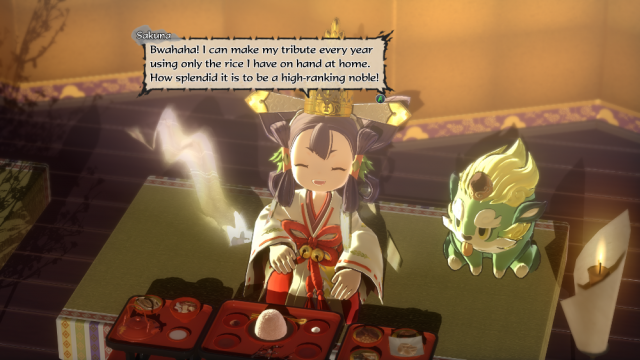
This sensation of growth applies also to how the game increases in quality as you play. Make no mistake: Sakuna fails to make a great first impression. In its first act it's heavy with exposition, its characters are annoying, combat feels stiff and shallow, and farm work seems tedious. If you stopped playing the game after the first few hours, you'd justifiably think it merely passable.
Yet the game grows on you. The misfit humans under your divine protection, once irritating, reveal their backstories, vulnerabilities, and aspirations and become treasured friends. The fighting system, once seemingly inflexible, reveals its depth through divine raiment skills, buffs, perks, and combat arts. Farm work, once a chore to be finished, demonstrates remarkable complexity as the game introduces new farming techniques and technologies. After hour three, you wouldn't be wrong to consider Sakuna a significant step back from developer Edelweiss' brilliant arcade shooter Astebreed; after hour 30, however, it would be reasonable to call it one of the better games of the year.
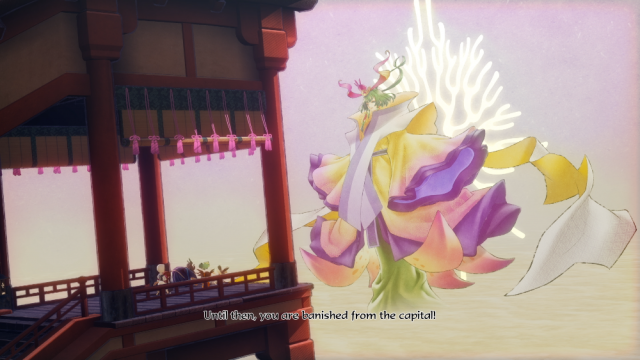
Set against a backdrop inspired by traditional Japanese mythology, Sakuna follows the privileged princess Sakuna, daughter of a warrior god and harvest goddess. When humans from the "lowly realm" stumble into the divine "lofty realm" and distract the princess long enough to cause a minor disaster, the elder goddess Lady Kamuhitsuki banishes Sakuna and the humans to the island of demons, Hinoe. There they must reclaim the land and fight back against the demonic infestation.
This story, as with most things in Sakuna, is surprisingly deep. Not only does the main plot line deliver lots of twists, turns, and revelations, but the characters within demonstrate some remarkable growth. Sakuna is the most obvious example — her grace and leadership at the end is a far cry from her conceited selfishness at the beginning — but the supporting cast gets plenty of attention as well. Through side-quests, conversations, and nightly group meals, Sakuna's human wards reveal themselves. They confront and overcome their personal demons and emerge as better, more complete people.
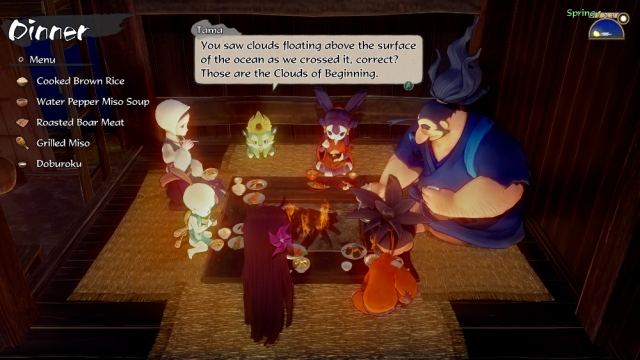
These "children of men", as the divine characters call them, do not exist strictly for narrative purposes. After Sakuna reclaims her parents' ancestral home on Hinoe, each human character settles into an important role. Tauemon, a samurai-turned-bandit, advises Sakuna on rice planting and harvesting techniques. Myrthe, a missionary from Ventania (a fictional country based on the Netherlands), cooks each nightly meal. Kinta, a hard-edged youth, serves as blacksmith. Yui, a shy girl, operates the loom. Kaimaru, an orphaned child, has a gift for communing with animals and brings back to the homestead many helpful beasts of burden.
Sharing moments and meals with your adopted family — they truly feel like family members by the time the credits roll — is but one phase of Sakuna. The other, interconnected phases are farm simulation and brawling. While you will spend more time out in the wilds of Hinoe, fighting demonic anthropomorphic animals, farming is the backbone of the game. It takes place across all four seasons and requires lots of prep work and patience. Essentially you till the land at the end of winter, plant seedlings in the spring, keep the stalks watered and fertilized through the summer, and harvest in the autumn.
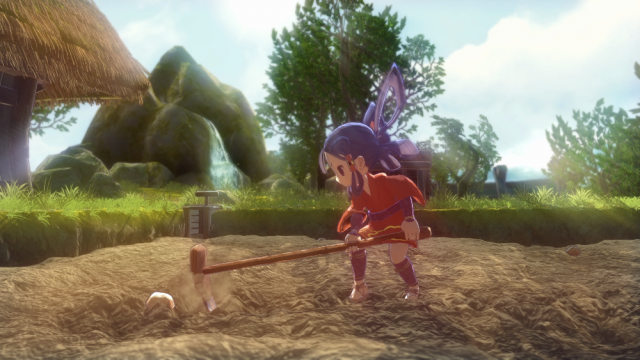
Farming is certainly engaging on a mechanical level — as you break up rocks and tame the frozen soil, you'll feel a visceral, tactile connection to the land — but it's far more gratifying on a strategic level. While the basics are simple enough, Edelweiss has created a farming framework that allows an incredible amount of customization and tactics, should you wish to dive a bit deeper. Do you want quantity over quality this harvest? Sow the seeds thickly and keep the plants in deep water over the summer as they ripen. Do you want to enhance the aesthetic of the rice? Make sure to sort the seeds using mud and polish the rice when it's cool out. Are there too many invasive plants hurting your crop? Introduce some ducks, which will eat insects and weeds. Is your rice diseased? Add a revitalizing powder to your manure and spread it on the field. The system of agriculture in Sakuna is incredibly complex and very rewarding if you know how to manipulate it.
A successful harvest means lots of rice to eat or, alternatively, deliver to the capital of the lofty realm in exchange for goods not found on Hinoe. It also means Sakuna grows in power. A harvest goddess' power is related to the vitality of her crops, you see. So, if at the end of the year Sakuna has a high yield, her HP rises. In the same way, an especially tasty crop translates to higher strength. Aroma affects magic, aesthetic corresponds to luck, etc. In this way, rice cultivation serves double duty: it's foundational to the game's farming simulation gameplay and its role-playing leveling system.
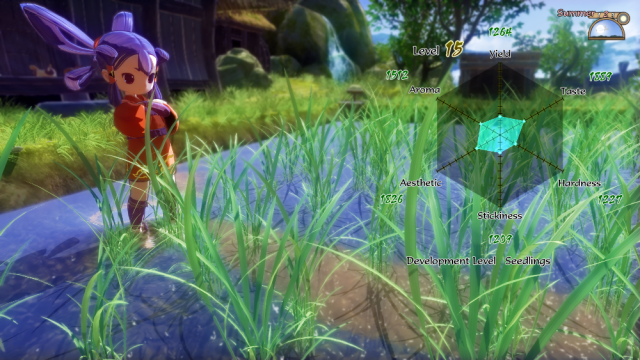
With better stats, you'll have the power necessary to leave the safety of the homestead and venture out into the wilderness of Hinoe. Here is where the game shifts genres — think Harvest Moon transforming into Muramasa: The Demon Blade. There are a few dozen areas on the map, each with plenty of demons and several exploration goals. Each plays out in a side-scrolling segment designed around 2D brawling. You'll fight monsters, discover resources, and ideally check off enough exploration goals to raise your global exploration level, thus unlocking new areas.
While the game introduces some light platforming in later levels, the primary goal out in the field is to beat up bad guys and find hidden treasures, ores, powders, and foodstuffs. Combat, like farming, appears simple at first but reveals its complexity as the game unfolds. Sakuna, as the scion of a war god, is a capable fighter. She fights with two main weapons, both inspired by farming implements, and can deploy light and heavy attacks, or string them together to form combos. Additionally, she can equip up to four special fighting skills, which deplete her magic gauge (it slowly refills over time). Her most important asset, and the conceit that elevates combat in Sakuna, is the divine raiment, an heirloom from her mother. It's essentially a mystical grappling hook, which permits the royal protagonist to latch on to ceilings and walls and control the rhythm of battle.

The divine raiment is a game-changer. It allows Sakuna to dance around the battlefield, and quickly swing to the back side of a rampaging attacker. It also supports up to four raiment skills at a time. These include Eldritch Enfeeblement, which temporarily reduces a grappled opponent's defensive vitality, and Soaring Bash, which tackles a grappled enemy to send them flying back. The best of all might be Tilting Windmill, which twirls a grappled demon around 360 degrees, then crashes it down, damaging any monsters caught in the crossfire.
If there's a flaw in the combat/exploration phase of Sakuna, it's repetition. You will replay many of the game's levels multiple times, in part because there are several exploration goals that require repeat visits, and in part due to the timed nature of the game. Sakuna unfolds according to a strict day/night cycle, where nighttime enemies are much tougher than their daytime counterparts. That, combined with the fact that your "fullness" — the stat that determines the rate at which you recover health — will deteriorate over the course of the day, means you'll need to retreat home at night for a good meal. The following day, with your belly full and the sun in the sky, you can attempt the mission once again.

This system makes sense in the larger context of the game, but at times it feels unduly rigid and restrictive. You can only accomplish so much in a single in-game day.
Sakuna was developed by Edelweiss, a Japanese indie studio comprised of only two people, which makes the game's 30-hour runtime all the more impressive. This is a substantial game with a meaty main quest and lots of room to explore outside the central storyline. Each area has several secrets, including masks and spirit boughs (weapon perks), plus optional challenges like "reach the exit in 90 seconds". You can also delay the main quest indefinitely while you find resources, discover new recipes, and manage the growth of your rice. Finally, there's a totally optional area called Amagaeshi Shrine, an expansive maze spanning 100 floors.
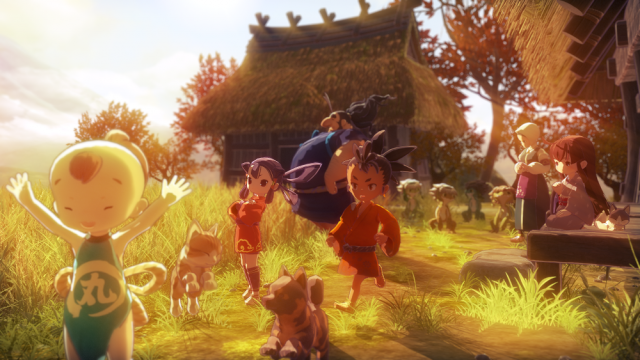
In terms of graphics and audio, Sakuna is solid. The game's soft, cel-shaded look works well with the theme and tone of the game, even if there are some facial shading issues and a few samey backgrounds. The soundtrack, composed by Hiroyuki Oshima, relies on traditional Japanese musical instruments — flute and drum in particular — to great effect. It convincingly transports you to feudal Japan.
Sakuna is eye-opening, not only because it shines a light on the nourishing, temperamental, and soulful qualities of rice but also because it demonstrates how a small team of two people can produce greatness by combining two seemingly incompatible genres. Edelweiss was able to turn an unusual, unlikely idea into a great game, by creating a solid framework of interconnected systems with versatile, tactical applications and by growing those systems over the course of 30-plus hours. Just as princess Sakuna takes a handful of rice husks and turns them into a bounty, Sakuna: Of Rice and Ruin takes a collection of disparate mechanics and transforms them into something greater than the sum of their parts.
VGChartz Verdict
8
Great
This review is based on a digital copy of Sakuna: Of Rice and Ruin for the NS, provided by the publisher.
More Articles
Excellent review! I'm really enjoying my time with Sakuna too. It feeds my soul!
This game has been such a blast so far probably one of the best games I've played this year.
This has become so popular so fast. I need to catch up and try it. Great review!
I like the art style of this one. Feels like they put alot of effort into it, to have it looking this stunning on the Switch.
























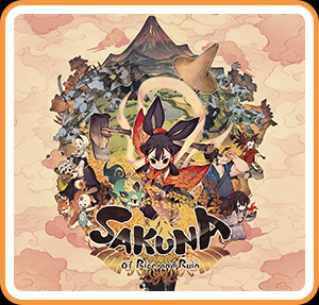





 Essay Pro
Essay Pro